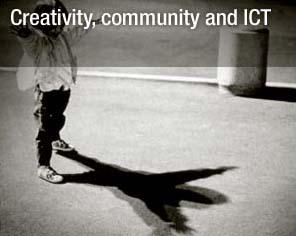2 Creative communities and ICT

We oppose
‘any prophetic pedagogy
which knows everything before it happens,
which teaches children
that every day is the same,
that there are no surprises,
and teaches adults
that all they have to do is repeat
that which they were not able to learn.’
Despite a vast literature on the topic of creativity in educational settings, most research indicates that educational institutions rarely promote the creative process. Many schools tend to focus on enculturating students into existing school knowledge, driven by a concern for individual children to acquire certain amounts of ‘statutory’ know-how before leaving a particular key stage. Research also suggests, however, that in settings where creativity is valued, and where creative processes are themselves the subject of learning, teachers and learners begin collectively to share and develop purposes and activities commonly ascribed to ‘creative’ individuals. Sources for such research include learning communities influenced by the work of educationists such as Dewey, Montessori, and Freinet. One international and celebrated contemporary example is the pre-school community of Reggio Emilia in Italy, founded by Loris Malaguzzi. Read Howard Gardner's vivid account (linked below) of the kind of activities found in Reggio's pre-schools, as well as the sorts of knowledge valued by those communities.
(PDF, 1 page, 0.12MB)
View document [Tip: hold Ctrl and click a link to open it in a new tab. (Hide tip)]
Although the children's creations are significant, Gardner argues here that they do not represent the heart of the Reggio enterprise. Rather, it is the social dimension of the Reggio community that is paramount: Reggio Emilia schools, Gardner concludes, are schools that ‘suit the entire community: teachers, parents, the physical setting, the region and above all the growing children working together to create a creative whole.’ You can read more of Gardner's views in The Disciplined Mind: Beyond Facts and Standardized Tests, The K-12 Education That Every Child Deserves, Howard Gardner, 2000.
Within creative communities, technologies are also usually integral to daily activity. Below is Loris Malaguzzi's account of a famous project undertaken in one of the Reggio Emilia pre-schools (an ‘Amusement park for birds’) which demonstrates the role that technology can play, even within a community of very young learners:
(PDF, 1 page, 0.12MB)
Creative communities often look at how the very latest technologies can be used to develop ideas and activities – and creative educational communities are no exception. New information and communications technology (ICT) can play an exciting role at all levels and stages of the educational process. The three case studies outlined in the next three sections of this unit provide some examples.
See how to use them to inform yourself and your colleagues about creativity within ICT in Activity 3.
Activity 3
Group task
(a) Discuss the kinds of information and communications technologies you are currently using in your school. Remember to include the purposes for the use of ICT in the curriculum.
(b) Case studies 1–3 in the following sections present a range of case studies of teachers and students using ICT. Assign each member of the group to explore one (or more) of the case studies in some detail. Each must prepare to report back to the group on:
(i) key aspect(s) of creativity supported by ICT use;
(ii) aspects of ICT and purpose not currently used in the school (refer to the notes you made in Activity 2);
(iii) elements of the case study that might be of interest to other colleagues.
In addition to the three case studies, you will also find links to other examples that show creative uses of ICT. These are included to extend the range of examples provided by the main case studies. You might also like to consider one or more of these for this activity.
